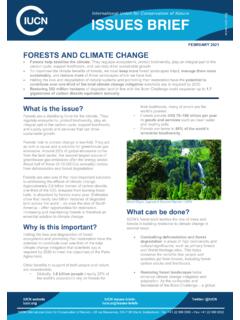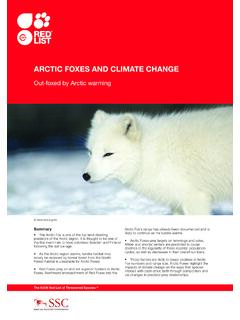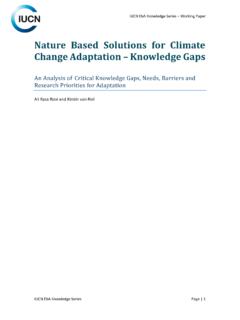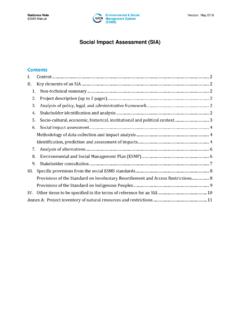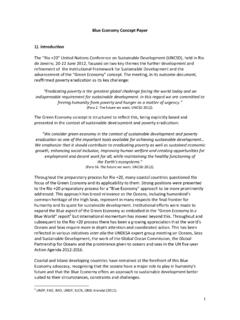Transcription of Environmental and Social Impact Assessment (ESIA)
1 Guidance Note ESMS Manual Environmental & Social Management System (ESMS) Version : 15 March 2020 Environmental and Social Impact Assessment (ESIA) I. Context This document provides guidance for conducting an Environmental and Social Impact Assessment (ESIA) and for preparing an ESIA report. It also serves as guidance for drafting the Terms of Reference for an ESIA. An ESIA is applicable for projects that have been identified by the Environmental and Social Management System (ESMS) screening as high or moderate risk projects, requiring full or a partial ESIA respectively1.
2 The purpose of the ESIA is to assess and predict potential adverse Social and Environmental impacts and to develop suitable mitigation measures, which are documented in an Environmental and Social Management Plan (ESMP). The scope and depth of the ESIA depends on the nature, complexity and significance of the identified issues, as established by the ESMS screening. For a full ESIA the scope is defined by a scoping study which involves relevant stakeholders to confirm the risks identified by the ESMS screening, to set priorities for the ESIA and to determine the types of assessments required for the ESIA.
3 The key elements, methodology and outputs of a scoping study are described in the ESMS Guidance Note on II. Key elements of an ESIA and an ESIA report The key elements of an ESIA and its report are described in this section. These elements must be thoroughly covered by a full ESIA for a high-risk project. A partial ESIA does not require as much background and baseline data as a full ESIA; the elements usually not covered in a partial ESIA are marked with an asterisk. The order and manner in which the information is presented in an ESIA report should be based on this outline.
4 1. Non-technical summary Summarise significant impacts in a way that can be easily understood by a non-technical audience, in particular local stakeholders. The summary includes how the identified impacts should be managed and points out any outstanding issues that require further action. 2. Project description Concisely describe the main parameters of the proposed project, including: The executing entities of the project ( main project lead as well as project partners) and their respective roles in the project The project s geographic location, preferably illustrated with appropriate maps3 Summary of the project (project objective(s), expected results/outcomes, outputs and main activities) Implementation arrangements.
5 3. Analysis of policy, legal and administrative framework* Describe the policy, legal and administrative framework within which the project takes place and identify any laws and regulations that pertain to Environmental and Social matters relevant to the 1 A partial ESIA typically focusses on the few delineated Environmental or Social impacts issues identified by the ESMS screening. 2 Available at 3 When including maps in the ESIA report, make sure that the sites mentioned in the report are clearly identified on the maps.
6 Page 2 of 6 project. This includes regulations about Environmental and/or Social Impact assessments to which the project must adhere as well as laws implementing host country obligations under international law. Explain the requirements of any co-financing partners, if applicable. Where pertinent, take into account legal frameworks for promoting gender equality. Flag any areas where the project might fall short on compliance. 4. Stakeholder identification and analysis The purpose of the stakeholder identification and analysis is to understand potential impacts on stakeholders and to clarify who should be involved in the ESIA process and how.
7 This is done by listing all relevant stakeholders based on any existing stakeholder analysis developed during the project design process and on general knowledge about the project context and its main stakeholders and elaborating the following: stakeholders interests in and expectations from the project; how they might influence the project (positively or negatively); a first appraisal or estimation of how their livelihoods could be impacted by the project (positively or negatively); and how they should be involved in the ESIA based on the information in the three items above.
8 Stakeholders should be disaggregated between men and women where relevant and feasible. It is useful to present the key findings of the stakeholder analysis in a matrix. The stakeholder analysis is considered a work in progress that should be adjusted as more information becomes available during the ESIA process and beyond. 5. Environmental and Social baseline* Describe and analyse the Environmental and Social context in which the project operates. While some broad contextual information is necessary, the analysis should focus on the immediate context of the project site and aspects that relate to the identified impacts in order to be relevant to decisions about project design, operation, or mitigation measures.
9 For general context data, consult to the extent possible - secondary data and existing analyses, including the situation analysis carried out as a previous project design step. To understand the context at the project site, it is usually necessary to collect primary data at the site. The main purpose of this section of the ESIA report is to provide an understanding of current Environmental and Social conditions that form the baseline against which project impacts can be predicted and measured during project implementation.
10 For moderate-risk projects that require only a partial ESIA and no scoping study, this section also provides an opportunity to substantiate the results of the ESMS screening by confirming potential impacts and/or identifying other potential impacts. The scope of the baseline analysis depends on the nature of the project and the issues identified by the screening. The analysis might cover a range of physical, biological, socio-economic and cultural features potentially affected by the project. The ESMS Guidance Note on Social Impact Assessment (SIA)4 provides complimentary guidance including a non-exhaustive list of topics relevant for understanding Social impacts.

